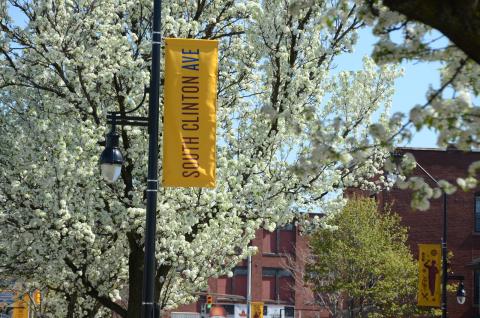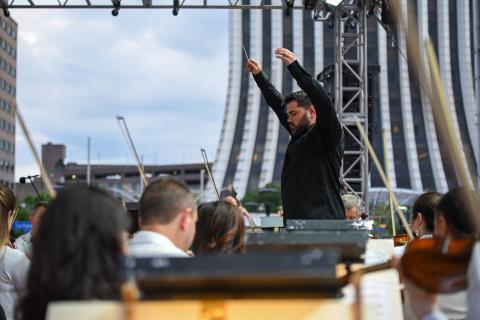Inner Loop East Project
The Inner Loop East Transformation Project converted a sunken section of expressway to the east of Downtown to an at-grade complete street including dedicated bicycle and pedestrian facilities. The construction of Union Street was completed in December of 2017. The project created six acres for redevelopment, which has continued since roadway construction was completed.
For information on the Inner Loop North Transformation Project, which will redesign the remaining 1.5-mile segment of the Inner Loop Expressway, please visit www.innerloopnorth.com.
Project Milestones
- S. Union Street was transformed to accommodate two-way traffic between Monroe Avenue and University Avenue.
- New signal lights on Union Street at Monroe Avenue, at Howell Street, at Broad Street, and at East Avenue were installed and activated. Howell St. remained one-way northbound between Monroe Avenue and South Union Street. Pitkin Street remained “one-way” southbound between E. Main Street and East Avenue. Pitkin Street was closed permanently from East Avenue to Savannah Street.
- Pitkin Street remained open one-way southbound from East Main Street to Charlotte Street.
- East Avenue, E. Broad Street and Monroe Avenue were reconstructed as at-grade streets, which eliminated three bridges over the former Inner Loop.
- Savannah Street was extended across the former Inner loop, connecting to the new S. Union Street.
Tomorrow's Inner Loop
In order to encourage sustainable economic growth and create a more livable Downtown, Rochester reconstructed a 2/3-mile stretch of the eastern segment of the Inner Loop Expressway between Monroe Avenue and Charlotte Street into a high-quality complete city street.
The new at-grade street has enhanced the area's livability, allowing people to easily walk and bicycle between neighborhoods and Downtown.
Inner Loop East: Design Overview
In addition to the clear livability benefits, the developable land surrounding the loop has been transformed into a mixed-use community that provides Rochesterians and visitors with places to work, live and play. As of early 2023, more than 500 housing units had been developed in the former Inner Loop area. More than 60 percent of these units are for residents earning less than the area median income.
The Inner Loop East project received many letters of support from the community, including real estate developers, neighborhood groups and business associations.
Project Benefits
Reconstructing the Inner Loop East from an expressway to a complete street was intended to produce a myriad of benefits, including:
- Increasing Traffic Safety: The project eliminated multiple non-standard features and three federal-aid bridges, two of which were structurally deficient and in need of major rehabilitation.
- Supporting Healthy Lifestyles and Improving Livability: By providing a boulevard with wide sidewalks and dedicated bicycle facilities while leveraging mixed-use infill development, the project encourages bicycle and pedestrian activity, helping to create a more livable and sustainable community.
- Reconnecting Neighborhoods with Downtown: The project removed a significant barrier to redevelopment in the East End, one of Rochester’s most important downtown districts.
- Promoting Development: Completion of this project opened roughly six acres of land to mixed-use redevelopment. Reclaiming this land generated tax revenues, created jobs and generated private investment. The Benefit-Cost ratio of this project was conservatively estimated to be between 1.9 and 2.2.
- Saving Money: Maintenance of this portion of the Inner Loop would exceed the cost of filling the below-grade expressway in and creating an at-grade street, while providing none of the benefits listed above.
- To learn more about all of the benefits along with details on the project, check out the Final Design Report:
Funding Sources
- Total: $20,995,036
- Federal (TIGER): $16,781,036
- State Match: $3,800,000
- City Match: $414,000
Public Participation in Construction phase
- A public informational meeting to present the construction implementation plan, was held on Thursday, Oct 9th, 2014 in the Kate Gleason Auditorium, at the Bausch & Lomb Public Library.
- A public informational meeting to present final design plans was held on Tuesday, May 6, 2014 at the Lodge at Martin Luther King Park.
- A public informational meeting and Public Hearing was held on Tuesday, February 4, 2014 at the Kate Gleason Auditorium in the Bausch & Lomb Public Library Building.
- The City hosted a pair of public open houses on November 6, 2013 to present and obtain feedback on refined design alternatives prior to completion of Preliminary Design.
- A Public informational meeting was held on Wednesday, August 28, 2013 at Rochester City Council Chambers.
Project Team
- Project Manager: City of Rochester - Department of Environmental Services
- Project Design: Stantec Consulting Services Inc
- Construction: Catco Construction






